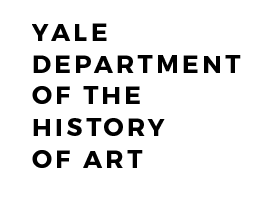Courses
Directed Research
By arrangement with faculty.
Fault Lines: Race, Gender, and Sexuality in Contemporary Art
This seminar examines moments in which prevailing representational paradigms of race, gender, and sexuality were disrupted and transformed, affecting three-dimensional paradigm shifts in reading of race, gender, and sexuality in fine art and visual culture. Students deepen their engagement with and writing on this work beyond the ghetto of identity politics by considering multiple methods of theoretical analyses simultaneously. Sites of rupture include the art and visual culture that emerged around the figure of the boxer through Jack Johnson and Muhammad Ali; African diaspora visual poetics in the youth culture of South Africa and Jamaica; and the work of contemporary artists Kalup Linzy, Mickalene Thomas, and Iona Rozeal Brown.
Globalization of Modern Craft
This seminar explores the development of self-conscious craft in the condition of modernity. Emerging from the work of the English designer-writer William Morris, modern craft has been intertwined with issues of identity (national and personal), class, and politics. Its intellectual foundation in the writings of Morris has also permitted modern craft to spread throughout the globe, taking root in different ways and at different times. The seminar investigates this geographic and temporal spread in a comparative fashion.
Henri Matisse
This seminar considers the art of Henri Matisse in all its phases and mediums: from the early work through Fauvism and the Nice period to the cutouts, sculptures, and drawings. Critical topics include the issues of decoration and ornament, the relation between color and drawing, and the studio as a workspace for the modern artist. We consult the recent Matisse literature on these topics (Bois, Wright, and Cronan, among others). But above all the seminar is meant to be an exercise in sustained looking at a complex body of work that was produced over a long period of time. What kind of oeuvre was it that unfolded in Matisse’s studio over five decades? Time permitting, the seminar makes a trip to the Matisse collection at the Museum of Modern Art or to the Barnes Foundation in Philadelphia.
Histories and Theories of Modern Architecture: The Rise and Fall of the Machine
Modern architecture is architecture defined by and for the age of the machine. We examine this central contention, tracing its formulation, evolution, digression, and eclipse from the waning decades of the nineteenth century to the 1960s. Drawing on the writings of architects, artists, critics, and historians, the seminar pays attention to those machines and mechanized processes that fascinated architects and historians, and considers these in relation to the parallel, yet distinct, ways that buildings served to mobilize and interpret literal as well as symbolic aspects of machines. Retracing this history of debates about mechanization provides an opportunity to reassess key assumptions and arguments about machines and their relationship to architectural production and discourse. Finally, we consider how, in the decades following WWII, mechanization gradually lost command of the narrative of modern architecture, asking how the waning of this dominance, (through notions such as second machine age, information society, post-industrial society, among others) comes to be registered in late-modern architecture, form, and space. Readings include works by Gottfried Semper, Karl Marx, Alois Riegl, Otto Wagner, William Morris, Frank Lloyd Wright, Adolf Loos, Patrick Geddes, Hermann Muthesius, Le Corbusier, Walter Gropius, Ludwig Mies van der Rohe, Adolf Behne, Hannes Meyer, Lewis Mumford, Sigfried Giedion, Nikolaus Pesvner, Pierre Francastel, Martin Heidegger, Konrad Wachsmann, Bruno Zevi, Marshall McLuhan, Alan Colquhoun, Reyner Banham, Manfredo Tafuri, Fredric Jameson, Nicholas Negroponte, and Beatriz Colomina, among others.
East-West Encounters in Chinese Art
Cultural exchanges between Europe, North America, and Asia from the seventeenth to twenty-first centuries, with a focus on Chinese arts and crafts. The influence of Chinese porcelain, decorative art, and architecture on interior and garden design in Europe; the role of Japanese woodblock prints in European and American art; Chinese artists, the Western oil painting tradition, and the tension between tradition and modernization; contemporary works that evoke the past.
eClavdia: Women in Ancient Rome
The contributions of Roman women to one of the greatest cities—and one of the greatest empires—in world history. Lost stories of real-life Roman women recovered from public and residential buildings, portraits, paintings, and other works of Roman art and architecture.
Egyptomania
Conceptual underpinnings of the use of ancient Egyptian motifs in architecture, painting, sculpture, and decorative arts throughout western Europe, the Middle East, and North America from antiquity to the present.
Futurism: The Shock of the New
Cultural and intellectual shifts in literature, philosophy, and the arts at the end of the nineteenth century, marking the rise of modernism. Futurism, surrealism, and other avant-garde movements that transformed into art the dramatic challenges of a new technological and psychological reality.
Greek Art and Architecture
Monuments of Greek art and architecture from the late Geometric period (c. 760 B.C.) to Alexander the Great (c. 323 B.C.). Emphasis on social and historical contexts.
